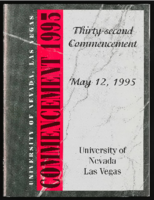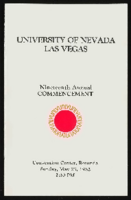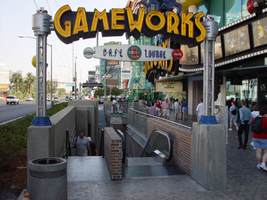Search the Special Collections and Archives Portal
Search Results

University of Nevada, Las Vegas (UNLV) 32nd commencement program
Date
Archival Collection
Description
Commencement program from University of Nevada, Las Vegas Commencement Programs and Graduation Lists (UA-00115).
Text

University of Nevada, Las Vegas (UNLV) 19th commencement program
Date
Archival Collection
Description
Commencement program from University of Nevada, Las Vegas Commencement Programs and Graduation Lists (UA-00115).
Text
Grace Hayes Papers
Identifier
Abstract
The Grace Hayes Papers (1900-1989) include personal papers and financial papers pertaining to the Grace Hayes Lodge (formerly the Red Rooster), a nightclub on the Strip in Las Vegas, Nevada. The collection includes financial documents, newspaper clippings about Hayes and her family, personal correspondence, career mementos, legal documents, and photograph albums.
Archival Collection
Ronnow Family Photographs
Identifier
Abstract
The Ronnow Family Photographs contain four black-and-white photographic prints of the Ronnow family in Southern Nevada from approximately 1870 to 1950. Also included is one large oversized black-and-white photographic print of the Old Rotary Club with C. C. Ronnow present.
Archival Collection
Ladies Auxiliary to the Veterans of Foreign Wars Collection
Identifier
Abstract
The Ladies Auxiliary to the Veterans of Foreign Wars Collection (1951-1977) contains publicity books, scrapbooks, community service records, newspaper clippings, correspondence, photographs, and newsletters pertaining primarily to the Fred S. Pennington post no. 1753 Ladies Auxiliary to the Veterans of Foreign Wars of Las Vegas, Nevada and the associated local chapter of the American War Mothers organization. The Ladies Auxiliary and the American War Mothers are non-profit organizations that assist in providing support and services to veterans and active service members. This material was formerly known as the Luanna Mitchell Collection.
Archival Collection
C. Vern Olmstead Professional Papers
Identifier
Abstract
The C. Vern Olmstead Professional Papers (1940-1975) contain materials related to Olmstead’s work as a prominent meat industry executive. The collection pertains to the preparation, cutting, storage, marketing, and distribution of meats including beef, pork, and poultry. Materials include reports, correspondence, newspaper and magazine clippings, photographic prints and slides, and publications regarding topics relevant to the handling and sale of meat in the United States and Canada.
Archival Collection
Congregation Ner Tamid Records
Identifier
Abstract
The Congregation Ner Tamid Records are comprised of annual reports, congregation bulletins, booklets, and digital and physical photographs documenting the history of Southern Nevada synagogue, Congregation Ner Tamid (CNT) from approximately 1974 to 2018. The collection includes two digital videos of CNT's final service at their Emerson Avenue in Las Vegas, Nevada location before moving to Valle Verde Drive in Henderson, Nevada. The collection contains a digital copy of a CNT scrapbook from 1974 to 1978 and recordings of original music used for CNT's services in 2016. The collection includes annual reports that highlight the synagogue's annual finances and major activities throughout the year and CNT's community newsletters.
Archival Collection
Patrick W. Carlton Papers on the Oral History of the Public School Principalship Project
Identifier
Abstract
The collection is comprised of University of Nevada, Las Vegas (UNLV) professor, Dr. Patrick W. Carlton's, research files dating from 1982 to 2011 in the "Oral History of the Public School Principalship" Project. The papers include research files about principals in Las Vegas, Nevada and Superintendents on the Clark County School District.
Archival Collection
Elizabeth Harrington Collection of Essays
Identifier
Abstract
This collection contains the original drafts of the thirteen essays that Elizabeth Harrington wrote about her life in early Las Vegas, Nevada. These articles were written from her memory and experiences of life in Las Vegas beginning in the early 1900s, and were published in the Nevadan section of the Las Vegas Review-Journal from 1975-1979.
Archival Collection

Photographs of Gameworks signs, Las Vegas (Nev.), 2002
Date
Archival Collection
Description
Site address: 3785 S Las Vegas Blvd
Sign details: Game Works is located on the underground level of The Showcase Plaza, which is also home to such establishments as M&M World and the Show case theatres. Two small gateway pylons for the Game Works center, stand on other side of staircases that lead to the underground facility. Just east of there a large wall front design hands approximately nine feet above the ground on the structure of the mall.
Sign condition: Structure 5 Surface 4 Lighting 5
Sign form: Pylon; Fascia
Sign-specific description: The large wall marquee that reads GAMEWORKS in all capitals, utilizes deep, yellow, steel, channel letters painted black on the exteriors. The slightly arched sign is on the West wall of the building, facing West from the East side of the strip. The interior of the text contains double rows of yellow neon. The cabinet, which the words sit upon, is a black steel cabinet shadowing the individual letters in one cabinet. The backing cabinet itself is illuminated from its interior, with middle section of the width of the cabinet is made of a steel grating. This function allows the blue neon on the inside to cast a blue glowing halo seen from the exterior. Sitting on top of the right hand side of the marquee are two steel boxes manufactured into the shape of a male and female figure dashing to the end of the sign. These figures are made of black steel box like formations while retaining a cartoon-ish silhouette. Their posture suggests motion or running. These figures are constructed in the same fashion as the black cabinet, which the text is supported upon. They too are glowing with the blue interior neon halo. In front of the large wall sign are the two, single sided, gateway pylons. They serve as markers for the stairs that lead the underground facility. They sit on either end of the large channel cut into the sidewalk. One faces South on the South entrance, and one faces North at the North end. The signage is actually a smaller replica of the large building front logo. The same interior lit cabinet supports the same design of yellow channel letters, with the backing "shadow" cabinet. A difference between the larger and smaller cabinets is that the cabinets are surfaced with the grated material. The only difference in the channel letters besides their obvious discrepancy in size, is that single rows of neon comprise the interior of the channel letters. On either side of the sign, two, "space age" themed posts provide support. They are topped with a sculpted cylindrical fashion capital. The bases for which they are attached to the concrete with, are blue in color. The actual shaft of the pole is made of several smaller pipes, with a plastic cylindrical tube in the center. Inside this tube is a string of attached incandescent bulbs running vertically. Below the text, suspended with two rods, is an oval shaped, aluminum cabinet. In the face of the cabinet there are the words "cafe" and "lounge" painted in blue. Over the painted text is blue neon. From both sides of the sign, the blue neon scrawl is visible Separating the two words is a black circle with a red neon rectangular shape in the center. The ends of the cabinet are made small circular cabinets approximately seven inches in diameter.
Sign - type of display: Neon; Incandescent; Backlit
Sign - media: Steel; Plastic; Fiberglass
Sign - non-neon treatments: Paint
Sign animation: none
Sign environment: The Game Works facility is located directly across the street from the pedestrian "Brooklyn Bridge" element of the New York New York and sit is the shadow of the MGM super pylon. The vibrant yellow of the sign do stand out as distinct among the tremendous and attractive signage of the Showcase plaza. The large channel cut into the sidewalk, along with its large surrounding counterparts, makes the entrance reminiscent of that of a subway. The plaza itself is self-contained and while standing along the front a person is enveloped in the plaza without being distracted by the rest of the strip itself. The large signage looms over a pedestrian while walking by, or shouts at you while sitting along the shrub filled flowerbeds.
Sign - thematic influences: The actual theme of the sign is correspondent to that of the business, which the sign advertises. The property is an interactive gaming facility and lounge. The use of the glow of a monitor or computer screen. The polished aluminum poles supporting the gateways are reminiscent of the futuristic, or "space-age" theming associated with the classic representations of science fiction in movies and television throughout the twentieth century. Such examples of this classic representations may be seen in television programs from the past like "Lost in Space," or even literary descriptions in Orson Well's "War of The Worlds" of Ray Bradbury's "Martian Chronicles" The combination of materials along with the innovative use of lighting also suggests electricity and digital elements which associate with the function of the facility.
Sign - artistic significance: If not significant for simply combining different elements to create a completely self-contained sign, it fits into the movement in Las Vegas's history , which is geared more toward the family. Not only the space that it occupies, but also the function itself in intended to attract young people if not children into it domain. It is an obvious standout for the vote to make Las Vegas move toward a more family oriented town. Aesthetically the signage is modern innovation on a classic design.
Surveyor: Joshua Cannaday
Survey - date completed: 2002
Sign keywords: Pylon; Fascia; Neon; Incandescent; Backlit; Steel; Plastic; Fiberglass; Paint
Mixed Content
